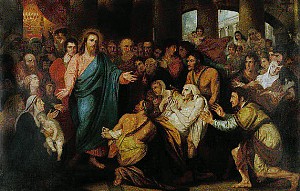Travels Through North America,
during the years 1825 and 1826
By His Highness,
Bernhard, Duke of Saxe-Weimar Eisenach

| |
The large and celebrated hospital of Philadelphia was established by the Quakers, and is under their direction. It owes its origin to voluntary contributions and posthumous donations. It is surrounded by a garden, and consists of a main building with two wings, besides other separate buildings, one of which is used for incurable lunatics, another for venereal patients, and others for household purposes and stables; for they here keep carriages, in which the convalescents ride when it is allowed. Behind the principal building is a kitchen garden, with a hot-house that contains many exotic plants. A particular building has been erected for the painting of Sir Benjamin West, who was a native of Philadelphia, and presented it to the hospital. The subject of the painting is Christ healing the sick. Neither the composition nor the execution of this painting appear to me to be successful; and perhaps it is only here, where they are unaccustomed to see great and well executed paintings, that this could excite such astonishing admiration as it has done. It is really singular that near this painting, which certainly has some merit, they should
hang a little picture, accidentally discovered in the city, which was daubed as a first essay by the same artist, when young.
The hospital is three stories high; in the lower story are the offices, the apothecary, the rooms of two physicians, one of whom must always be in the house, and the library, which contains a very handsome collection of books on medicine and natural history. As a sort of antiquity, they show here William Penn's arm-chair; a leaden statue, made in England, of this eminent man, of full size and in the Quaker dress, stands in the square in front of the house. Corridors run through both wings, and thence you enter the rooms, each containing twelve patients; they are under the care of female nurses, and lay on wooden bedsteads; only the maniacs have them of iron. Throughout this house extraordinary cleanliness is observed. To the melancholy, every species of employment is permitted, provided it does not interfere with their own safety or that of other patients. Some worked in the garden, two were occupied as cabinet-makers, and a lock-maker from Darmstadt was engaged two years in making a musket, for which he has prepared a colossal lock of wire and tin.
When I returned from this remarkable institution, I received a visit from a literary gentleman from Leipzig, Mr. Rivinus. This young man had already been two years in this city, collecting observations on America, to make known in Germany. I was much interested by him. He appeared to me well suited to gather information concerning the new world and to present it to the old; perhaps he may contribute to make German literature known to the Americans.
Mr. Vaux had the politeness to accompany me to some literary institutions. We went first to the Franklin Library; this collection, which amounts to thirty thousand volumes, was established by voluntary subscriptions, and is supported by the same means. The subscribers have the right to take books home with them; the library contains likewise a large collection of copperplates, and amongst others a handsome edition of Hogarth's prints. The library is arranged in two great halls, and as a curiosity they show Dr. Franklin's library chair. The statue of this famous man stands in a niche over the entrance of the house, and was presented, as the inscription says, by Mr. Bingham, the meritorious father of Mr. Bingham of Montreal. After that we went to the Philosophical Society, which also owns a building, and possesses a rich library and cabinet. The librarian, Mr. John Vaughan, a venerable gentleman, equally esteemed for his benevolence and urbanity, performed the honors. He showed us the handwriting of several celebrated individuals of the revolution. The cabinet contains, amongst other things, a mineralogical cabinet, a collection of shells, &c. Finally, we went to the State House, and saw the plain and not very large hall in which the Declaration of Independence was signed on the 4th of July, 1776. This hall is decorated with a wooden statue, the size of life of President Washington; on the pedestal is the following inscription: "First in war, first in peace, first in the hearts of his countrymen."
|
